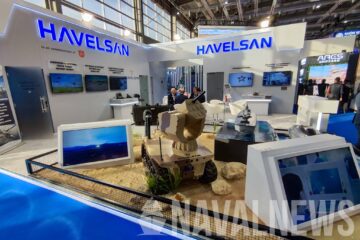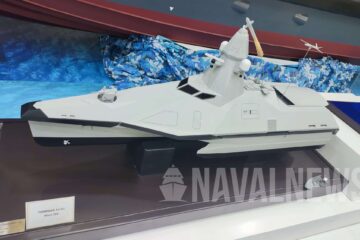This unveiling represents a significant advancement in the Anti-Surface Warfare (ASuW) capabilities of ULAQ, propelling it to new heights in terms of stand-off range and operational effectiveness.
The ULAQ, previously equipped with small missiles such as L-UMTAS and Cirit, conducted its inaugural missile firing during the Denizkurdu 2021 large-scale exercise. ARES Shipyard had earlier introduced ASW (Anti-Submarine Warfare) and kamikaze variants of the vessel, showcasing its adaptability for diverse naval missions.
Naval News learned that ARES is currently working with Roketsan to mount ÇAKIR missiles on the USV, but they are still at design phase.
The incorporation of ÇAKIR cruise missiles marks a significant development for the ULAQ ASuW variant, elevating its stand-off range from 8 kilometers to an impressive 150 kilometers. Notably, ÇAKIR is an Imaging Infrared (IIR) guided missile, eliminating target discrimination issues in littoral waters and significantly enhancing the vessel’s threat capabilities against adversary units in naval scenarios.
This enhancement not only bolsters the ULAQ’s firepower but also establishes a crucial link in unmanned sea-air cooperation. The ÇAKIR missile, with its extended range, can be launched from Turkish Unmanned Aerial Vehicles (UAVs) such as AKINCI and AKSUNGUR, showcasing a seamless integration of air and sea assets. Moreover, the missile can be guided by another unit after launch, demonstrating a sophisticated level of control and coordination in naval operations.
The ULAQ’s adaptation to the ÇAKIR cruise missile aligns with the evolving trends in unmanned maritime systems, presenting a formidable force multiplier for modern navies. ARES Shipyard’s commitment to innovation and versatility underscores the ULAQ’s pivotal role in shaping the future of naval warfare.
The unveiled conceptual image at the World Defence Show 2024 signals a paradigm shift in naval capabilities, solidifying the ULAQ’s position as a cutting-edge, autonomous platform with enhanced precision-strike capabilities. As naval forces worldwide seek to modernize and integrate unmanned systems, the ULAQ armed with ÇAKIR cruise missiles emerges as a significant development for the Turkish Navy.
About ULAQ USV

ULAQ is the brand name for the Unmanned Surface Vehicle (USV) product family developed by ARES Shipyard and Meteksan Defence, which covers a variety of platform types, capabilities, and roles.
ULAQ was first unveiled in October 2020. It has a 400 km range, 65 km/h speed, day/night vision capabilities, and encrypted communication infrastructure, which can be operated from mobile vehicles, navy headquarters, or from sea platforms such as aircraft carriers or frigates. Its missions include intelligence, surveillance, reconnaissance, surface warfare, asymmetric warfare, escort missions, and strategic infrastructure protection.
The prototype carries a launcher for four laser-guided Cirit missiles and two laser-guided long-range anti-tank missiles (L-UMTAS) produced by Turkish missile manufacturer Roketsan. The ULAQ prototype carried out test-fires of Cirit against a land target on 26-27 May 2021 during the Denizkurdu-2021 exercise of the Turkish Navy. After the firing trials, the anti-surface warfare (ASuW) version completed the acceptance trials.
Following the ASuW version, which is the initial phase of the project, the development will begin on autonomous surface vehicles for intelligence and electronic warfare, mine hunting, anti-submarine warfare, firefighting, and humanitarian aid/evacuation.
ULAQ USV main specifications
- Length: 11 meters
- Speed: 35 knots
- Range: 400 Kilometers
- Armament:
- ASuW – 4x Cirit and 2x UMTAS missiles
- Base/Harbor Protection – 12.7 mm RWS
- ASW – ASW Rockets (can be fitted with LW torpedoes)
- Control station: Can be controlled from ground and sea stations
About ÇAKIR cruise missile

Roketsan’s Cruise Missile ÇAKIR, which can be launched from land, sea and air platforms, will become a new force multiplier for the armed forces with its state-of-the-art features and effective warhead. With its new technologies, Roketsan continues to create new concepts on the battlefield.
ÇAKIR can be launched from fixed- and rotary-wing aircraft, unmanned attack aircraft (AUAVs)/UCAVs, AUSVs, tactical wheeled vehicles and naval platforms, offering operational versatility against land and surface targets. With a range of over 150 kilometers, ÇAKIR engages ground targets, coastal land and surface targets, strategic land targets, field targets and caves, among others.
- Range : 150+ km
- Weight : ≤ 330 kg
- Diameter : ≤ 275 mm
- Warhead Weight : 70 kg
- Warhead Type : High-Explosive Semi-Piercing Blast Fragmentation Thermobaric
- Flight Engine : Turbojet Engine Solid Fuel Launch Engine
- Guidance: Mid-Phase Guidance: Inertial Navigation System Antijam Global Navigation Satellite System (GNSS) Radar Altimeter Barometric Altimeter Terrain Referenced Navigation System Terminal Phase Guidance: Imaging Infrared-IIR RF Seeker Hybrid (IIR+RF) Seeker






